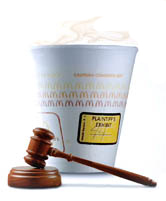Out of the Sacramento Bee comes this horrible story of 2-year-old Malyia Jeffers, whose feet and one hand were amputated after a 5-hour wait in an emergency room of an urgent care center. She was sitting there with a potentially deadly invasive Streptococcus A infection. While she waited, according to the article, the girl became increasingly lethargic, fever raged, and her skin turned splotchy. After awhile, she couldn’t even walk.
This is the nuts and bolts of it:
[The father] Ryan Jeffers, 29, said he pushed for immediate care, but was rebuffed. After about five hours, he said, he ambushed a nurse and demanded to see a doctor. The physician took blood samples that suggested Malyia was in liver failure, Jeffers said. She was taken by ambulance to the pediatric intensive care unit at Sutter Memorial Hospital. Doctors there had her flown to Stanford aboard a helicopter.
It turned out the girl was in septic shock from a Streptococcus A infection that somehow invaded her blood, muscles and internal organs. About 10,000 cases of “invasive group A streptococcus” infections occur every year in the United States, and as many as 20 percent of patients die from the condition, according to the Centers for Disease Control and Prevention.
Now I don’t know if faster treatment would have saved this child from catastrophe (and potential death). But let’s for the moment assume it would have. What legal alternatives are available?
And the answer may surprise you, as they are somewhat limited. For out in California, they enacted a one-size-fits-all tort “reform” with a cap of $250,000 on non-economic damages (pain and suffering). The state did this in 1975. And it hasn’t changed in the last 35 years. Adjusted for inflation, it would be about a million dollars today. But it has never been adjusted.
That’s right, a lifetime of missing three limbs, if she survives, and this child might receive compensation of $250,000 for her pain and suffering. Less, of course, the money spent to hire the experts, take the depositions, get all the records, and get the case to trial after a few years, and paying the lawyers to do it. Assuming that lawyers can be found to put forth the money and absorb the risk for a contingent fee.
The statute was challenged on constitutional grounds in 2009, but that effort sadly failed.
That, ladies and gentlemen, is what you get when you sign on for tort “reform.” A big, fat gift to the insurance companies and a healthy dose of immunity and protection for those that are negligent. If there was negligence in this case, the burden will not be borne by those that were negligent, but by those that were victimized. Of course, to the extent that the child is poverty-stricken at some point, it will be the taxpayers that get the burden.
Make no mistake about it. Tort “reform” shifts the burdens of loss to the victims and taxpayers and protects the wrongdoers. That is what it is.
Hat tip: Jonathan Turley with this post on the subject, and Scott Greenfield.



